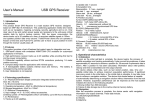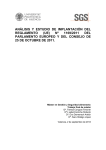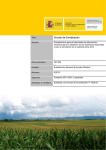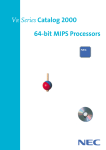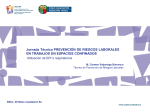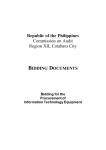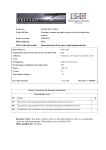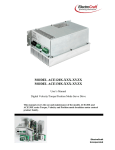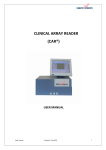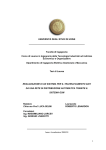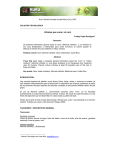Download Wireless module of localization and control for security
Transcript
Wireless module of localization and control for security J. Luna Rodríguez1, V. Barranco López2 , D. Bullejos Martín2 and A. Sabariego Hernández1 1 Department of Architecture of computers, Electronic technology and Electronic 2 Department of Electrical Engineering E.P.S., Córdoba University C/ María Virgen y Madre s/n 14071 Córdoba (Spain) Phone/Fax number:+0034 957 218363, e-mail: [email protected], [email protected], [email protected], [email protected] Key words M2M be a mixture of different techniques (processing, electronics and communications). Automotion, control and management of fleets, tracking systems, security and emergency systems are among the most fruitful sectors. All of them need the combination of two complementary systems, GPS and GSM/GPRS. They are advanced programmable systems which require special features of connectivity and transmission speed. Solar energy, photovoltaic, GPS, anti-theft 2. 1. Introduction The main objective of this Project is to develop a complete system based on the combination of GPS and GSM/GPRS systems applied to the localization and watching for the security of solar panels outside the cities, as well as an alarm system (in case of stealing or failure) through a mobile phone. Abstract. Solar parks and photovoltaic solar centrals are proliferating to produce more electric power. They are generally placed far away from city centres; consequently thefts of the panels occur quite commonly. We introduce an anti-theft system: a GPS programme which could detect the change of placement of a panel and track its position. Nowadays, the rapid growing of communication systems through GPS and mobile phone systems, joined to the boom of renewable energies (due to the decrease of traditional energy sources and the pollution they cause), make possible the joint of both markets with the goal of obtaining new applications, such as the control, tracking down and security of the fleets. Solar energy (and specifically photovoltaic solar energy in our case) is in a continuous rise, and the companies making use of this type of energy in their industrial processes are growing, saving quite a lot of money in the long term. Its continuous evolution makes them more and more accessible, not only for companies but also for people. Solar photovoltaic energy is an economic reliable solution which can be adapted to many applications, having interesting features such as low maintenance and failure rate. In the communication market, the term M2M is used to refer to the systems allowing the machines to communicate through company information systems either with other machines (M2M stands for Machine-toMachine in English), or with people through the mobile (M2M also stands for Machine-to-Mobile) for the bidirectional transfer of data in real time. M2M solutions are designed to increase productivity, use and reduction of costs and time, to improve processes, service to the client and, above all, they mean a new way of doing things. The combination of different technologies in a single device (data capture, transfer and processing) makes Objetive The system tests the state of a signal which will report the owner on the position of the panel. If it is not, the system will calculate its position through the GPS module and will report (through an alarm system by SMS to the mobile phone of the owner) on the exact position of the fleet, to be able to begin the process of its recovery. Each solar panel will integrate a complete system (GPS module, GSM/GPRS module, failure detection module, GPS antenna, GSM/GPRS antenna and electric supply module) which will be integrated in its structure to avoid detachment. The main objective of this project, as has been stated before, is the fleet of solar panels which could need to be repaired, substituted or recovered from burglary, due to the need of placing companies in industrial floor far away from cities, and also to the high cost of the devices for the obtaining and transformation of photovoltaic energy. This makes installations expensive, as well as meaning an additional cost to substitute the lost elements by new ones, making a constant problem for the affected companies. Thanks to GPS technology, it now is possible to solve the problem. We can always know the localization of the devices and report, through GSM/GPRS to the mobile of the owner, on either a possible failure occurred or on a problem with its localization. This is not only a solution to the security problem, but it is also a really efficient system to detect burglary and malfunction, with the resulting recovery by the owner. It will also mean a loose of contracts with companies devoted to the recovery of stolen objects, because it is now the owner who can recover his/her panels without paying any money or instalments for the service. For the realization of this project we need GPS instruments (for the tracking and localization) and GSM/GPRS instruments (for sending information). Some years ago, the main problem found to develop this type of industrial applications was the high prices of such devices, which have been lowered nowadays because of the increase in the number of manufacturers and models. 3. Description of the application Each solar panel (placed at the end of a frame) will integrate a GPS module, a GSM/GPRS module (both of them in the same device for this Project) and an electric supply system. The brain of the system is the combined technology GSM/GPS module for the acquisition and sending of data (for this case) the placement of the solar panel. This application can fulfil three main tasks: - Data supervision and control. - Data acquisition. - Generation and sending of an alarm signal. GPS Satellites seen Satellite 1 Satellite 2 Satellite 3 Satellite 4 Programming Interface Data acquisition and transmission (Module GSM/GPS) Module GPS Module GSM Signal reception SMS sending Satellite 5 Satellite 6 Satellite 7 Satellite 8 Reception equipment (mobile) panel through its corresponding circuit. If it is stolen, the module will be supplied by the battery for only a limited amount of time. To supply the module a 3.8 volt current is needed in an operation range 3.4-4.2 volt. Following the above described procedure, a circuit will be needed to charge the battery supplying the module. Such circuit needs a converter continuous-current continuous-current (cc/cc), which adapts the panel current (between 29.48 v and 35.5 v) to the 12 volt required by the charger, and thus charges the battery to supply 3.8 volt to the module. 3.1.1. Regulation of current An electronic converter is needed to adjust the output current to a constant value according to the input current available and the output current needed. Not many converters are designed which use general purpose components. Instead, integrated converters are found, so the time and number of components is dramatically reduced, thus having a more economic circuit. The main features we must have into account to choose cc/cc integrated converters are: - Input and output current: reducer or amplifier. - Margin of input current: the bigger, the better. - Output current. - Range of temperature. - Size. For this work we have selected a PCB integrated cc/cc converter. It is a four terminal converter that gives a constant output 12 volt current needed to supply the charge circuit. It is quite small because of its design. Depending on the model and brand of the solar panel used, the current it gives is different (between 29.48 and 35.5 volt, following the technical specifications of the manufacturer). According to these data, we have chosen a converter that allows a wide margin of input current, 1872 volt, (± 5), enough for different panels with an output current of 250 mA. Data screening The data acquisition and transmission module, that is, the GSM/GPS module, is the most important part of this system because it controls and sends the alarm signal. Broadly speaking, this module takes the position data from the GPS receptor (latitude, altitude, length, number of satellites seen, etc.) and then it collects them in a message to be sent. 3.1. Electric supply of the system The electric supply of the system is obtained from the own solar panel to which it is attached; we have chosen a type called ‘online’. This type of supply is described as follows: a battery is placed, which is supplied by the voltage of the solar 3.1.2. Battery As it has been said before, the supply current for the module must be 3.8 volt in a 3.4-4.2 margin. We got them with a Lithium-Ion battery (Li-Ion) of 3.7 volt, whose use is set by the module itself. According to the user’s manual, the battery must correspond to this type, rejecting other types (Ni-Cd, Ni-MH, etc.) because they can entail overvoltage of the module and its consequent damage. In addition, lithium batteries are the most recommendable ones because they have the following advantages: - High energy density. They keep a big charge per volume unity. Light weight. With the same volume, they are lighter than Ni-MH o Ni-Cd batteries. - - - Thin objects. This makes them especially interesting to be integrated in portable devices, which require thin objects. Higher current per cell. Each battery gives 3.7 volt, the same as three Ni-Cd batteries (1.2 V each). No memory effect. Linear discharge. During discharge, the battery voltage remains the same, which avoids the need of inefficient regulator circuits. Low self-discharge rate. When a battery is kept, it slowly self-discharges though it is unused. For NiMH batteries such self-discharge can be 20% per year. For Li-Ion batteries it is only 6% (± 0,2% daily). This manual also indicates that the battery must have at least 500 mAh to stand current peaks of 2 A. We have chosen a 1300 mAh. The battery must be linearly placed between the module and the battery, a Schottky diode and, parallel to the diode, a tantalum condenser of 1µF. The diode is used to avoid the possible inverse current, that is, to help the current circulate in one way, from the battery to the module and not the other way round. The condenser is needed to get a constant input current. - Programming language, preferably high level. According to all these selection criteria, we have chosen the GM862-GPS module, Telit brand, with its own development system, Telit Evaluation Kit (EVK2) for the programming phase. It is a module which offers an easy solution to be implemented, with a wide range of temperatures, antenna connectors, SIM built-in interface which is needed for the sending and reception of SMS, 13 input-output general purpose ports, and a digital analogical converter. It is especially oriented for telemetric applications of tracking and security. It also includes a Python interpreter, which allows the handling of the equipment internally with an application written in the same language. It includes an additional 3MB nonvolatile memory and 1.5 MB RAM We first considered the idea of using a GPS module with other GSM/GPRS, together with a microcontroller in charge of the control and burglary report, but we finally found a wide range of built-in modules in the market, which offer a more compact solution and which are cheaper than years ago, due to the high growing of these technologies in the security sector, as well as the tracking and emergency systems. 3.2.1. Features of the GSM/GPRS module 3.2. GMS/GPS Module It is the set of elements (software and hardware) which allow to determine (in our case) the position of our stolen panel and to report on its placement. We need, on the one hand, a receiver device through GPS and, on the other hand, a GSM-GPRS modem to facilitate the sending and reception of sms and data to the owner. There exist a wide variety of GPS and GSM/GPRS modules in the market. They can be found either separately or both integrated into the same device. This last type is called built-in module. The possibility to find both complementary integrated technologies has been crucial for our choice, due to the small space requirement. We have chosen a built-in module because it is cheaper than buying independent technologies. In addition, we have noted its availability and variety in the market nowadays. The GSM/GPRS modem is only a cellular terminal similar to a mobile, lacking the keyboard and the display. So, it needs to be registered by a phone operator that will facilitate a number (either contract or card) and the number of a Message Centre for the reception and sending of SMS. It is a four-band GPRS modem (850/900/1800/1900 MHz), class 10. The majority of the control software (or the modem commandos) fit to the Hayes norms, AT+ commandos that have the following general format: AT+Commando = Datum <CR> <LF> Configuration writing / sending of messages, and AT+Commando? <CR> <LF> Other considerations are the following: Configuration reading / states of the modem. Dimensions, because the application requires a reduced size, the same as the rest of the components. As it can be seen, the goal of the transmission is identified by the characters <CR> y <LF>, excepting for some special commandos. - The type of encapsulation. The sensitivity of the GPS receiver, which must be as high as possible. The type of chipset built-in the receiver, crucial for the reception of the satellites. The type of GSM bands (dual, three-band, four-band) and its speed (GPRS class 9, class 10, etc.). The option to have an internal memory for our code. The possibility to include a development system which makes programming easier and faster. There are a great number of AT commandos for different goals: to programme the port, the sending of SMS messages, the management of messages memory inside the modem card, the establishment of voice calls, or even the possibility of sending and receiving faxes and emails, though these are not necessary for our application. 3.2.2. Characteristics of the GPS module The GPS module includes a single chip SIRFstarIII receiver, the most potent of the market, with 20 channels, a high sensitivity for reception (-159 dBm), and a medium consumption of 70 mA per operation (including the GPS antenna consumption). Such module is GSM controlled, AT commandos or NMEA command statements. As it can be seen in this case, the interpreter fulfils the task of the external microcontroller. This communicates with the module through a serial virtual port by AT commandos, instead of using the physical port. The disadvantage found in this configuration is that it is not practical for applications that need large programming and, so on, long scripts. Only a 3 MB memory is available, though it is enough for our application. 3.2.3. Python Interpreter 3.2.4. Antennas As it was said above, the module includes an interpreter that allows the internal control of the modem, by writing the control application directly in a high-level language called Python. The incorporation of the internal interpreter is especially directed to low-complexity applications, which could be fulfilled by a small micro-controller that handles the input and output pins, as well as the module itself through the serial port by AT commandos. The following can be a diagram of its configuration: The module has got two antenna connectors, a GSM and a GPS one, which are described below. • GSM Antenna To allow the GSM module working properly and realizing its functions, an antenna needs to be attached, which allows its registration in the operator’s net. The antenna facilitated by the manufacturer has the following characteristics: Frequency Range GSM900 DCS1800 PCS1900 GSM900 DCS1800/ PCS1900 Polarization Lineal 50 ohm Impedance 1W Gain To eliminate the external controller and make the operation sequence programming easier inside the modules, the following is included: - The interpreter core Python script. Script means the small programmes made in such language. - 3 MB non-volatile memory (Flash ROM) for data and programmer script. - 1.5 RAM used by the Python interpreter. The diagram corresponding to such configuration will be: 880 - 960 MHz 1710 - 1880 MHz 1850 1990 MHz 0 ~ 0.5 dBi 0.5 ~ 1 dBi 4 max. -40 ~ 85 ºC This is a three-band antenna for PCB with an MMCX connector, specific for mobile applications. • GPS Antenna For a better performance, the GPS receiver needs an antenna with the specifications found in the user’s manual. There are many manufacturers that allow antennas with different filtering options, gain levels, type of connectors, level of output impedance, cable length and assembly options. Taking into account such variety, the manufacturer of the module recommends an antenna with the following electrical specifications: Range of frequency 1575,42 MHz (GPS L1) Current Tension Gain 3.4 - 4.2 VDC Impedance Electricity consumption 50 Ω 3 dBi > Gain > 1,5 dBi 20 mA max. The antenna used is a compact one. It has a 5 m long cable and magnetic assembly. The supply tension ranges over 3 to 5 volt (in the specified margin) with 5 ohms impedance. It is connected to the module by an MMCX connector. References [1] [2] [3] [4] [5] [6] 4. Conclusions A remote-controlled system through mobile for the checking and localization of a solar-plates fleet controlled by GPS has been presented in this paper. The possibility of finding a device in the market which combines GSM/GPRS technology with GPS, functioning in one module, allows the company to reduce costs for those industrial applications in which money is considered. Solardelvalle. http://www.solvalle.es/ . 2007. Arrow-Iberia Electronica. Módulos GM862-GPS. http://www.arrowiberia.com/ . 2007. Bustos, Eduardo J. et al. WLAN y Bluetooth: el despegue de las comunicaciones inalámbricas locales y su integración con las redes móviles. Telefónica Investigación y Desarrollo, pp 83-98. Nº 25 · Marzo 2002. Anon. Increased interest in WiMAX will impact the cellular M2M market. Microwave Journal 50 (10): 52-52. Oct 2007. Gasieniec L, Kranakis E, Pelc A, et al. Deterministic M2M multicast in radio networks. Theoretical Computer Science 362 (1-3): 196-206. Oct 11 2006. Sadoun B, Al-Bayari O. Location based services using geographical information systems. Computer Communications 30 (16): 3154-3160. Nov 3 2007.





